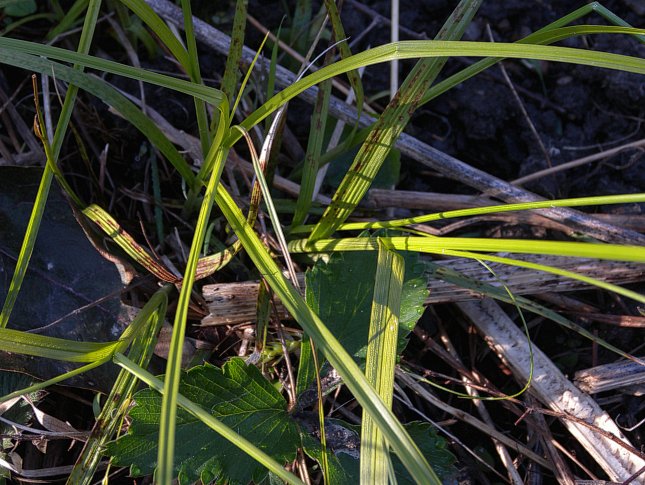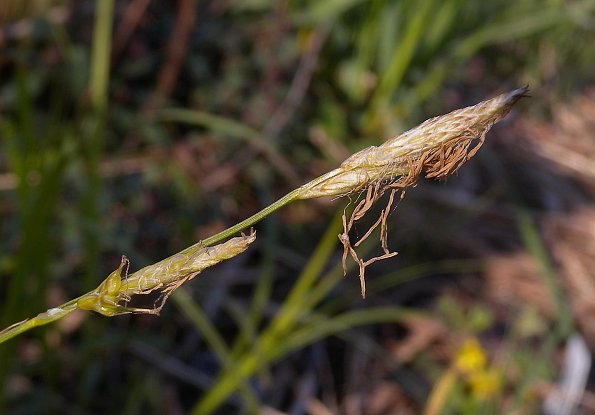
Pistillate spikelets are 1.5–3 cm. long, light green (immature) to tan (mature), and cylindrical in outline; they have 10-30 spreading to ascending perigynia and their scales; the latter face in all directions. Perigynia (sacs covering the achenes) may be slightly to moderately overlapping along the central axis of each spikelet. Each perigynium is 4.5–7 mm. long and glabrous, consisting of an ovoid-globoid body that abruptly tapers into a long narrow straight beak. This beak is as long or longer than the body; the beak terminates in 2 slender teeth. The body of the perigynium is terete (circular in circumference) and it has 2 fine longitudinal veins that are opposite from each other, otherwise it is smooth. The pistillate scales in front of the perigynia are 3.5–6 mm. long; they are shorter than or the same length as the perigynia. These scales are lanceolate in shape, tapering to slender-acute tips that are sometimes awn-like; they are green-veined in the middle, otherwise they are white-membranous. The peduncle of the terminal staminate spikelet is about 1.0–2 cm. long, stiff, and erect; the peduncles of lower staminate spikelets, if any, are shorter. The peduncles of the lower pistillate spikelets are the same length to twice the length (1.5–6 cm.) of the pistillate spikelets; these latter peduncles are filiform (very slender & worm-like) and pendulous, causing the pistillate spikelets to droop. At the base of the peduncle of each pistillate spikelet, there is a leafy bract that is similar to the leaves, but somewhat smaller in size; the bracts of staminate spikelets are scale-like and insignificant.

The blooming period occurs from mid- to late-spring, lasting about 1-2 weeks. The florets are cross-pollinated by the wind. Afterwards, the perigynia and their achenes (one achene per perigynia) become mature and disarticulate from the inflorescence during the summer. The achenes are 2–2.5 mm. long, bluntly 3-angled, and ovoid in shape; there is a short narrow stipe at the base of each achene that is straight, while at the apex of the achene there is a short narrow beak that is bent. The root system is fibrous-rhizomatous. This sedge reproduces by reseeding itself and by forming clonal offsets from the rhizomes.
Cultivation: The preference is light shade to dappled sunlight, more or less mesic conditions, and loamy soil containing decaying organic material. Growth and development begins relatively early during the spring. By late-summer, this sedge becomes dormant, dying down to leafy basal shoots.
Range & Habitat: The native Long-beaked Sedge occurs occasionally in the northern half of Illinois, while in the rest of the state it is rare or absent (see Distribution Map). Illinois lies along the southern range-limit of this sedge, which is more common in areas that lie further to the north. Habitats include mesic woodlands, wooded terraces along rivers, shaded riverbanks, poorly drained flatwoods in upland areas, and woodland openings. In Illinois, this woodland sedge is associated with such deciduous trees as hickories and oaks, although further to the north it can be found in mixed conifer-deciduous woodlands. Generally, Long-beaked Sedge occurs in slightly disturbed to high quality natural areas.

Faunal Associations: Sedges (Carex spp.) in woodlands are a source of food to various insects, including the larvae of a butterfly, Satyrodes appalachia (Appalachian Brown), larvae of several leaf-mining moths (Elachista spp.), larvae of Cosmopterix clemensella (Clemen's Cosmopterix Moth), stink bugs, and miscellaneous aphids. The seeds of sedges in woodlands are eaten by such birds as the Bobwhite Quail, Wild Turkey, immature Ruffed Grouse, Eastern Towhee, and various sparrows. When these plants are abundant, they provide cover for small rodents, ground-nesting woodland birds, and other wildlife.
Photographic Location: The wildflower garden of the webmaster in Urbana, Illinois.
Comments: This unusual woodland sedge has a striking appearance because of its long-beaked perigynia and its pistillate spikelets that droop from long slender stalks (peduncles). As a result, it is easy to identify when its inflorescence is produced. There is considerable variability in the number of staminate and pistillate spikelets that are produced per fertile shoot, and the relative lengths of the perigynia and their pistillate scales are also variable. An alternate common name for Carex sprengelii is Sprengel's Sedge.